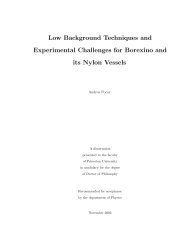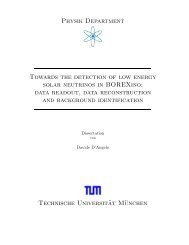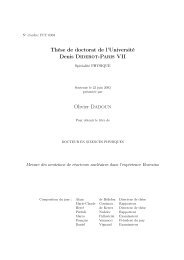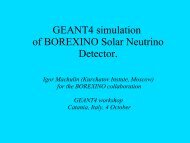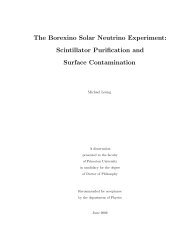Development of a Liquid Scintillator and of Data ... - Borexino - Infn
Development of a Liquid Scintillator and of Data ... - Borexino - Infn
Development of a Liquid Scintillator and of Data ... - Borexino - Infn
You also want an ePaper? Increase the reach of your titles
YUMPU automatically turns print PDFs into web optimized ePapers that Google loves.
4.3 The Reconstruction Program<br />
detector, the time delay introduced by scattering <strong>and</strong>/or absorption-reemission processes, <strong>and</strong><br />
the time jitter <strong>of</strong> the PMT. The probability density function for a single photoelectron Ø is<br />
derived from a Monte Carlo simulation <strong>of</strong> the detector <strong>and</strong> archived in a look-up table. For the<br />
CTF, it is shown in fig. 4.7.<br />
Multiple Hits<br />
In the CTF the data acquisition registers only the arrival time <strong>of</strong> the first photoelectron for<br />
each electronic channel while the total number <strong>of</strong> photoelectrons per channel arriving within<br />
a time window <strong>of</strong> a few hundred nano seconds is recorded with an ADC. In BOREXINO the<br />
arrival time <strong>of</strong> each photoelectron will be recorded, if they arrive with at least 140 ns distance.<br />
In BOREXINO the probability for multiple hits is greatly reduced compared to the CTF, as<br />
each PMT covers a smaller solid angle. In the CTF, for a 1 MeV event the average value is 3<br />
hits per PMT, while in BOREXINO it will be only 0.2 hits per PMT.<br />
The probability for PMT , that the first one out <strong>of</strong> Ò photoelectrons has been registered at the<br />
time Ø can be calculated to be<br />
Ô ØÒ Ò ¡ Ø ¡<br />
<br />
Ø <br />
Ò <br />
where Ø is derived from the measured time Ø in the following way:<br />
Ø Ìevent Ø emission Ø flight Øscatter ¦ Ø jitter<br />
Ìevent Ø min Ü Ý Þ Ø<br />
Ø Ìevent Ø min Ü Ý Þ Ø<br />
Ø Ø Ø Ø min Ü Ý Þ Ø Ø min Ü Ý Þ<br />
The Ø min Ü Ý Þ are archived in a large multidimensional look-up table for each grid point<br />
<strong>and</strong> PMT (they are derived from the Monte Carlo simulation, which was described in the last<br />
section).<br />
Noise Hits<br />
The problem <strong>of</strong> (white) noise hits, which occur uncorrelated with the scintillation event, is<br />
equivalent to a probability density constant in time. This is already solved by substituting<br />
Ø with the maximum probability Å Ø . More correctly one has to add to Ø<br />
<strong>and</strong> renormalize afterwards. In practice this is equivalent to an additional constant bias to<br />
ÐÓ ÄÆØ× ¡ ÐÓ , which thus only slightly affects the minimization process. For a noise<br />
rate <strong>of</strong> 1 kHz one gets ¡ Ò× .<br />
<br />
55



